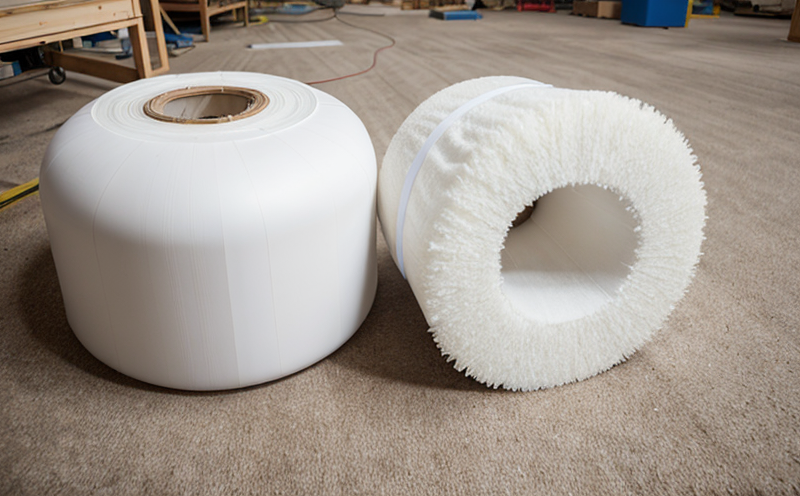ISO 354 Sound Absorption Coefficient Testing
The ISO 354 standard is an international benchmark used to measure the sound absorption coefficient of materials, especially in architectural and industrial settings where noise control is essential. This test is crucial for ensuring that materials perform as expected in absorbing sound energy within specific frequency ranges.
Sound absorption is a key factor in designing spaces such as auditoriums, studios, and theaters to achieve optimal acoustics. The standard defines the methodology for determining how much of an incident sound wave is absorbed by a material or surface at various frequencies. This information is vital for ensuring that materials meet specified performance criteria.
The test procedure involves placing the sample in a controlled environment where it interacts with a sound field generated by a speaker. The absorption coefficient, typically expressed as a percentage, quantifies how much of the incident sound energy is absorbed rather than reflected or transmitted. This measurement helps determine the suitability of materials for specific applications.
Understanding sound absorption coefficients is critical in various sectors, including construction, automotive, and industrial design. In construction, it aids in selecting appropriate finishes to enhance room acoustics. For automotive manufacturers, it ensures that interiors have acceptable noise levels while maintaining comfort. In industrial settings, it helps in minimizing unwanted noise pollution.
The testing process involves several steps: specimen preparation, setup of the test chamber, sound generation, measurement, and calculation. Specimens are carefully prepared to ensure they represent the material's characteristics accurately. The test chamber is calibrated according to ISO 354 standards to provide consistent results. Sound levels are generated using a specified frequency range, typically from 125 Hz to 4000 Hz, ensuring comprehensive evaluation.
The absorption coefficient is calculated based on the incident and reflected sound pressures measured at specific frequencies. This calculation provides a quantitative measure of how effectively the material absorbs sound energy. The results are presented in a graph or table format for easy interpretation by those involved in design and compliance verification processes.
Accurate testing ensures that materials meet required standards, enhancing product performance and reliability. For quality managers and compliance officers, this test is essential for maintaining high standards in production environments. R&D engineers can rely on these tests to refine material formulations and improve acoustic properties. Procurement professionals benefit from knowing the sound absorption characteristics of potential suppliers' products.
The ISO 354 method has been widely adopted due to its reliability and precision, making it a go-to standard for assessing sound absorption coefficients globally.
Why It Matters
Sound absorption plays a critical role in creating comfortable and functional environments. In buildings, adequate sound absorption helps mitigate noise pollution, enhance speech clarity, and reduce reverberation times. For instance, theaters require materials that absorb mid-to-high frequency sounds to ensure clear dialogue and balanced acoustics.
- Enhanced Comfort: Sound-absorbing materials help create quieter spaces by reducing background noise, which is essential in residential and commercial settings.
- Better Acoustic Design: Accurate sound absorption data allows for better design decisions that improve the overall acoustic experience. This is particularly important in concert halls where precise acoustics are crucial.
- Energy Efficiency: By reducing noise levels, materials can contribute to more efficient HVAC systems and lower energy consumption.
The importance of sound absorption cannot be overstated, as it directly affects the quality of life in various environments. From classrooms to offices, from recording studios to public spaces, ensuring proper sound absorption is key to achieving desired acoustic properties.
Quality and Reliability Assurance
Ensuring reliable results through ISO 354 testing involves rigorous quality control measures. Specimens must be prepared according to strict guidelines to maintain consistency across tests. Calibration of the test chamber is critical, as even minor deviations can lead to inaccurate absorption coefficient readings.
- Calibration: Regular calibration ensures that the equipment accurately reproduces sound fields and measures reflected sound pressures.
- Specimen Preparation: Samples must be prepared without introducing artifacts or alterations that could skew results. This includes ensuring specimens are free from dust, moisture, and other contaminants.
- Data Analysis: Careful analysis of the collected data ensures that only reliable measurements are reported. Any anomalies are investigated to understand their cause before finalizing reports.
The reliability of ISO 354 testing is further enhanced by adherence to international standards, which provide a consistent framework for all participants. This standardization ensures that results are comparable across different laboratories and jurisdictions, promoting trust in the testing process.
Environmental and Sustainability Contributions
The use of sound-absorbing materials contributes positively to environmental sustainability by helping reduce noise pollution and energy consumption. By minimizing the need for additional insulation or HVAC systems, these materials can lead to reduced carbon footprints.
Incorporating sustainable practices into testing further enhances the benefits. For example, using recycled materials in specimens not only reduces waste but also promotes circular economy principles. Additionally, conducting tests in a manner that minimizes energy use during calibration and data analysis supports eco-friendly operations.
The ISO 354 test process itself can be adapted to include sustainable practices such as reusing equipment and minimizing the use of hazardous chemicals. By integrating these elements into the testing protocol, laboratories can contribute significantly to environmental conservation efforts while maintaining high standards of accuracy and reliability.





